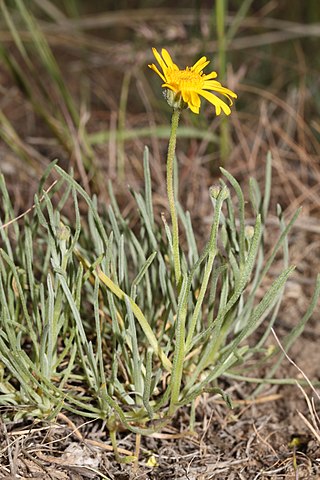
Erigeron aliceae is a species of flowering plant in the family Asteraceae known by the common name Alice Eastwood's fleabane, or simply Alice's fleabane. It was named for American botanist Alice Eastwood, 1859 - 1953.

Erigeron aphanactis is a species of flowering plant in the family Asteraceae known by the common name rayless daisy, or rayless shaggy fleabane. This wildflower is native to the western United States, primarily the Great Basin and Colorado Plateau regions.

Erigeron argentatus is a species of flowering plant in the family Asteraceae known by the common name silver fleabane. It is native to the western United States.

Erigeron bloomeri is a North American species of flowering plants in the family Asteraceae known by the common name scabland fleabane.

Erigeron compactus is a species of flowering plant in the family Asteraceae known by the common names cushion daisy, fernleaf fleabane, and compact daisy.

Erigeron eatonii is a North American species of flowering plants in the family Asteraceae known by the common name Eaton's fleabane.

Erigeron foliosus, known by the common names leafy daisy and leafy fleabane, is a North American species of flowering plants in the family Asteraceae.

Erigeron glaucus is a species of flowering plant in the family Asteraceae known by the common name seaside fleabane, beach aster, or seaside daisy. It is native to the West Coast of the United States.

Erigeron inornatus is a North American species of flowering plant in the family Asteraceae known by the common name California rayless daisy, California rayless fleabane, rayless fleabane, Lava rayless fleabane

Erigeron linearis is a species of flowering plant in the family Asteraceae known by the common name desert yellow fleabane or narrow leaved fleabane. It is native to western North America.

Erigeron parishii is a species of flowering plant in the family Asteraceae known by the common names Parish's daisy and Parish's fleabane.

Erigeron utahensis is a North American species of flowering plant in the family Asteraceae known by the common name Utah fleabane.

Erigeron petrophilus is a species of flowering plant in the family Asteraceae known by the common names rockloving erigeron or cliff fleabane. It is native to the mountain ranges of California from Siskiyou County south as far as San Luis Obispo County and El Dorado County. It also grows in southwestern Oregon.
Erigeron sanctarum is an uncommon species of flowering plant in the family Asteraceae known by the common names saints fleabane and saints daisy. It is endemic to California, where it is known from San Luis Obispo and Santa Barbara Counties including two of the Channel Islands.

Erigeron tener is a North American species of flowering plant in the family Asteraceae known by the common name slender fleabane. It is native to the western United States, largely in the Great Basin, in the states of California, Arizona, Nevada, Utah, Oregon, Wyoming, Idaho, and Montana.

Erigeron lonchophyllus is an Asian and North American species of flowering plant in the family Asteraceae known by the common name shortray fleabane.

Erigeron maniopotamicus is a rare species of flowering plant in the family Asteraceae known by the common name Mad River fleabane. It is endemic to northwestern California, where it is known from only four locations in Humboldt and Trinity Counties.

Erigeron rhizomatus is a rare species of flowering plant in the family Asteraceae known by the common names Zuni fleabane and rhizome fleabane. It is native to western New Mexico and eastern Arizona in the United States. It is a federally listed threatened species.

Erigeron modestus is a North American species of flowering plant in the family Asteraceae known by the common name plains fleabane. It native to northern Mexico and the southwestern and south-central parts of the United States.
Erigeron tenellus is a North American species of flowering plant in the family Asteraceae known by the common name Río Grande fleabane. It is native to the valley of the Río Grande, on both sides of the international border. It is found in the US state of Texas as well as in Nuevo León and Tamaulipas in México.




















